RogueRose
International Hazard
    
Posts: 1585
Registered: 16-6-2014
Member Is Offline
|
|
Removing mercury from mercury vapor lights
I came across some bulbs that are ~42" long x 26mm OD quartz bulbs that are made for UV curing for printing presses. These bulbs are meant to handle
300-500 watts per inch, so we are talking about 12-15KW per bulb for the standard lengths! The wire leads have insulation rated at 25kvdc, IDK what
actual voltage they run at, but the capacitors they use are rated at 2500v and are 5-12 MF, so pretty large compared to normal caps you come across
(the look like microwave oven caps but much larger).
I noticed little shiney specs inside the bulb and after shaking it for awhile I noticed a nice ball coagulate and used it to collect the remaining
specs and it seems there's ~1ml of mercury per bulb.
I would think that filling a bulb with water would allow the mercury to collect and pool at the bottom making it easier to remove & the same water
could be used repeatedly for many bulbs & then distilled to remove any potential mercury contamination. I've never dealt with mercury like this,
so I could be totally wrong, so please correct me if you know better.
Just so you can get an idea of what these bulbs are, here are some links to near identical products. I think these are just newer and have different
model #'s but they look basically identical except mine don't have the gold or grey material near the "neck" (where the electrode would be).
https://www.cureuv.com/products/aradiant-dl50139-uv-curing-l...
https://www.cureuv.com/products/aradiant-sqp60-uv-curing-lam...
These bulbs also have an interesting electrode on either side, they kind of remind me of spark plugs as they look like a tightly wound wire around a
solid center rod.
I might be able to get a large amount of these at "waste" prices as the company that had them is being liquidated. These are all at least 10 years old
and the packaging (6-8 layers of bubble wrap) is not in the best shape, but the bulbs seem fine.
|
|
|
j_sum1
Administrator
       
Posts: 6218
Registered: 4-10-2014
Location: Unmoved
Member Is Offline
Mood: Organised
|
|
Save the quartz tubes.
How much Hg would there be in one bulb? I would have thought it would be extremely small. (That is, less than a tilt switch.)
|
|
|
draculic acid69
International Hazard
    
Posts: 1371
Registered: 2-8-2018
Member Is Offline
|
|
If U can see tiny hg droplets just crack the tubes and pour it out.dont contaminate water with it
|
|
|
j_sum1
Administrator
       
Posts: 6218
Registered: 4-10-2014
Location: Unmoved
Member Is Offline
Mood: Organised
|
|
I would have thought that very small droplets would stick to the glass enough to make this impractical. I know the adhesion is not strong, but for
very small size drops I would have thought it significant.
My inclination would be to make a shallow trough and fill it with dilute nitric acid and soak each bulb for a while. Then rinse with water. I doubt
there is enough Hg to make recovery of that worthwhile economically, but you do want to capture it for environmental reasons. IMV, the quartz is the
real treasure here.
|
|
|
itsallgoodjames
Hazard to Others
  
Posts: 276
Registered: 31-8-2020
Location: America Lite
Member Is Offline
|
|
Are all fluorescent bulbs made of quartz tubes?
Nuclear physics is neat. It's a shame it's so regulated...
Now that I think about it, that's probably a good thing. Still annoying though.
|
|
|
Dr.Bob
International Hazard
    
Posts: 2656
Registered: 26-1-2011
Location: USA - NC
Member Is Offline
Mood: No Mood
|
|
Most are not,as you don't want the UV to escape, only the visible light. But if it is a UV lamp, it would need to be a material that does not absorb
UV, so some sort of quartz glass.
Bob
|
|
|
RogueRose
International Hazard
    
Posts: 1585
Registered: 16-6-2014
Member Is Offline
|
|
Quote: Originally posted by j_sum1  | Save the quartz tubes.
How much Hg would there be in one bulb? I would have thought it would be extremely small. (That is, less than a tilt switch.)
|
Well I guess I mis-calculated the amount. The little ball was about 5-6mm diameter by 3-4mm high and I have to say it is less than what is in my old
thermostat tilt switches and is about 50-60% of what is in one glass tube.
|
|
|
RogueRose
International Hazard
    
Posts: 1585
Registered: 16-6-2014
Member Is Offline
|
|
Quote: Originally posted by j_sum1  |
I would have thought that very small droplets would stick to the glass enough to make this impractical. I know the adhesion is not strong, but for
very small size drops I would have thought it significant.
My inclination would be to make a shallow trough and fill it with dilute nitric acid and soak each bulb for a while. Then rinse with water. I doubt
there is enough Hg to make recovery of that worthwhile economically, but you do want to capture it for environmental reasons. IMV, the quartz is the
real treasure here. |
I agree that the adhesion of the mercury keeps it from easily just dumping it out, so that is why I was mentioning using water to flush it out.
I think using 2 containers and just dump water from one to the other through the tube. I have this adapter for 2L bottles that allows 2 to be screwed
together and it creates a vortex as it drains. Something like this might do a good job as it spins so fast it just sticks to the sides, leaving the
center empty, and should do a good job cleaning it. Maybe a slightly acidic solution might be beneficial..
|
|
|
metalresearcher
National Hazard
   
Posts: 731
Registered: 7-9-2010
Member Is Offline
Mood: Reactive
|
|
No. standard fluorescent tubes are just made of ordinary glass. Only tubes or bulbs for UV or blacklight are made from quartz. You can test it by
carefully tapping the tube with a rigid object, e.g. a metal object. When it has a long fading sound, it is quartz.
|
|
|
Vomaturge
Hazard to Others
  
Posts: 285
Registered: 21-1-2018
Member Is Offline
Mood: thermodynamic
|
|
If you do end up doing something with these, and end up with a bunch of unwanted capacitors, I might be interested in those, especially if they're "No
PCB". They pose an electrocution risk, but I know how to manage that and it would be a huge waste to throw them away.
[Edited on 24-3-2021 by Vomaturge]
I now have a YouTube channel. So far just electronics and basic High Voltage experimentation, but I'll hopefully have some chemistry videos soon. |
|
|
violet sin
International Hazard
    
Posts: 1475
Registered: 2-9-2012
Location: Daydreaming of uraninite...
Member Is Offline
Mood: Good
|
|
Have you checked to see if they have a composition similar to metal halides? I've been told that MH lights have Thalium and other metal halides
besides mercury... Kilowatt lights might be more fine tuned with additional salts. Do be careful in that regard. Now to be fair, it was from a
gentleman that fell from grace of the laser forums. In his defence, did seem intelligent and had a pile of laser stuff on auction at the time, never
shafted me on any of them.
But I did buy sodium from him years ago. Along with a mess of argon ion laser heads, some HeNe, few power supplies and all kinds of wacky sci stuff.
Anyhow I had access to a small pile of MH(metal halide) and a heap of HPS lighting(high pressure Na) 600w-1000w most (end of life bulbs returned to a
shop).
He said don't waste my time trying to get myself sick, or at least wear protection if I was bound and determined to go through with it. Besides
the drops of Hg, you could see square planar metallic crystals in there. I opened a couple sodium lamps that were internally failed, they could be
heard fizzing on a foggy day. Left the MH alone, after breaking outer envelope and snipping leads to condense their volume. Now I've just a small
pile of things collecting dust somewhere.
Edited for spelling, not th-u-lium, meant th-a-llium, sorry
[Edited on 24-3-2021 by violet sin]
|
|
|
Panache
International Hazard
    
Posts: 1290
Registered: 18-10-2007
Member Is Offline
Mood: Instead of being my deliverance, she had a resemblance to a Kat named Frankenstein
|
|
Man they're expensive...maybe resell them and buy a pound of mercury...lol.
|
|
|
RogueRose
International Hazard
    
Posts: 1585
Registered: 16-6-2014
Member Is Offline
|
|
Quote: Originally posted by Vomaturge  | If you do end up doing something with these, and end up with a bunch of unwanted capacitors, I might be interested in those, especially if they're "No
PCB". They pose an electrocution risk, but I know how to manage that and it would be a huge waste to throw them away.
[Edited on 24-3-2021 by Vomaturge] |
The caps have "NO PCB" written on them and on the box. Some of them have a little corrosion on the outer surface, I cleaned one up with a brass wire
brush and the corrosion wasn't that deep. I think there were about 12-15 boxes of these, each weighing close to 50-60lbs and 18"x18" x ~15" and they
had various size caps, all the same voltage just different capacitance.
I talked to the person in charge of cleaning out the facility and I've been given the go-ahead to do whatever I want with the bulbs, caps and any
other electrical equipment I come across. I just have to give a % of anything I get to the guy in charge of cleaning the place out (it's 160,000 sq
ft of industrial equipment, storage racks and some very interesting tech - but some of the machines would need their own 15x25ft storage facility for
each machine. But I'm excited to see what's left in there after they sold one room's worth of equipment and found it was more trouble than it was
worth (it's dangerous to move everything out- roof has been leaking for 10 years so there's air handling & insulation collapse all over the place.
But there's probably many 100's to 1000's of these quartz UV bulbs and I'm trying to figure out what to do with the besides just sending them to
landfill (I don't think they care about the mercury in them.... Even though I've informed them of this). I think should actually be paid to to
clean the bulbs up properly with removal of the mercury. I wonder what the fines are for improper disposal of this type of thing....
So if anyone wants some of these bulbs, I'd be willing to ship some of them - total length is about 35-36" including the short ceramic insulator on
each end. I'll be posting some pics later today and I'll be inspecting the facility at the end of next week so I'll have a better idea of what's
available.
|
|
|
RogueRose
International Hazard
    
Posts: 1585
Registered: 16-6-2014
Member Is Offline
|
|
Here are some pics I took of the terminals. I don't know the wall thickness, I'm guessing it is 1 or 1.5mm - possibly 2mm, but the OD is 26mm, just
over 1" from a number of my measurements.
The actual tubing with an OD of 26mm is 29" long the rest has been drawn out and condensed to hold the electrode.
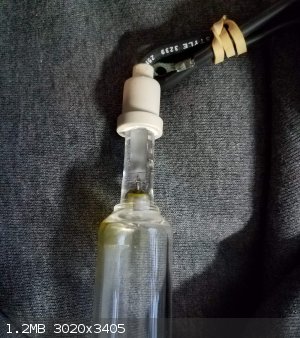 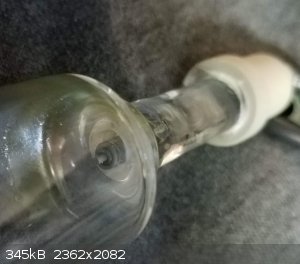 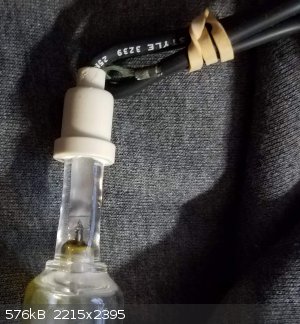 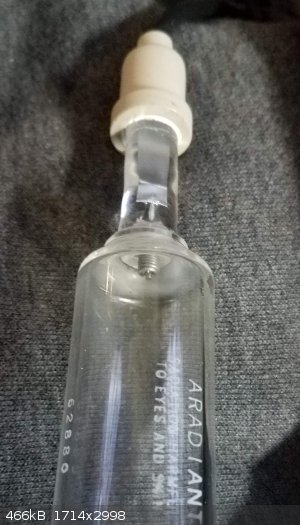 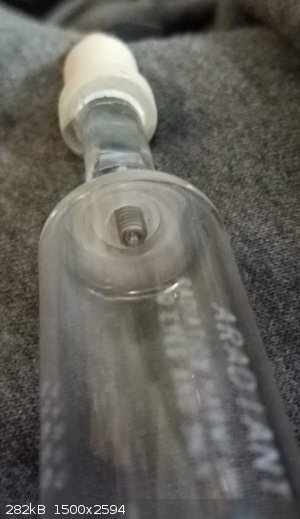 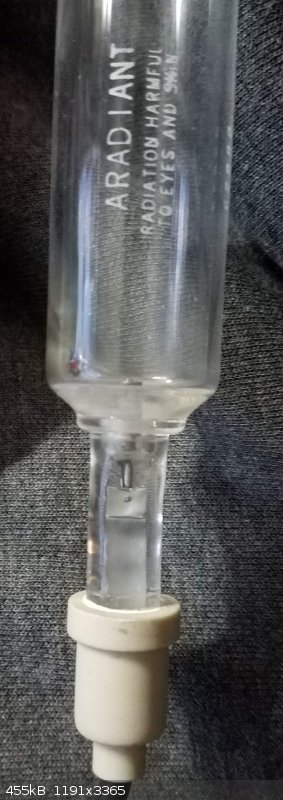 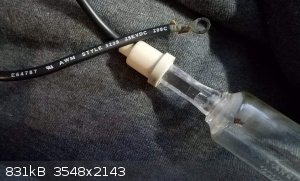
|
|
|
Vomaturge
Hazard to Others
  
Posts: 285
Registered: 21-1-2018
Member Is Offline
Mood: thermodynamic
|
|
Looking on Alibaba, you could possibly get over 100$ for each of the capacitors in those boxes, if you can find buyers. That's after
devaluing them 50% for being rusty. Some were on ebay a little while ago too, for similar price.
If you get to the point where those capacitors are just going to the landfill, I'll buy maybe a box or 3 for a lower price, maybe a few $ per
microfarad. You can probably find a lot of other high voltage hobbyists who'll buy too. Who knows I may even invest in all of them plus storage units
if it looks like I can find a buyer in the short term.
Keep me posted, these things are more valuable more versatile and (in my opinion) more fun than a few hundred gm of mercury. Whether they are safer is
debatable.
[Edited on 13-4-2021 by Vomaturge]
I now have a YouTube channel. So far just electronics and basic High Voltage experimentation, but I'll hopefully have some chemistry videos soon. |
|
|
rockyit98
Hazard to Others
  
Posts: 283
Registered: 12-4-2019
Location: The Known Universe
Member Is Offline
Mood: no mood is a good mood
|
|
if good condition , just sell and buy anything you wish.
"A mind is a terrible thing to lose"-Meisner
|
|
|